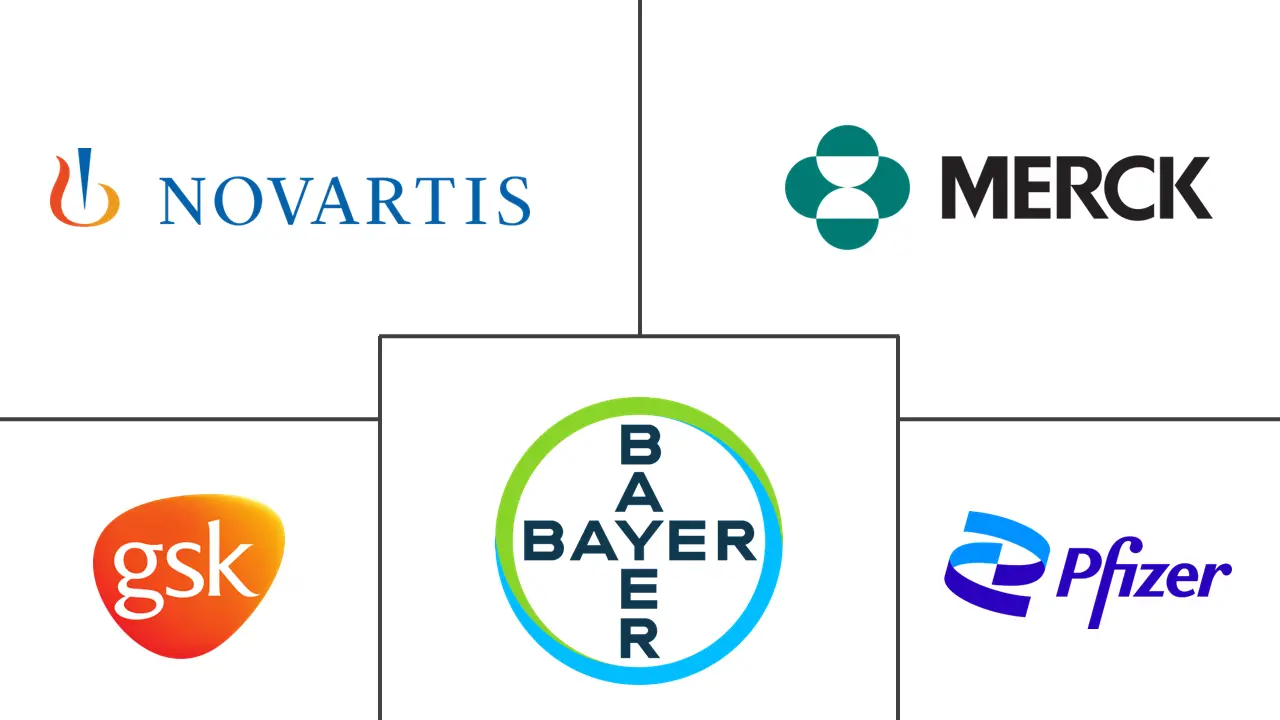Global Antiparasitic Drugs Market Size and Share
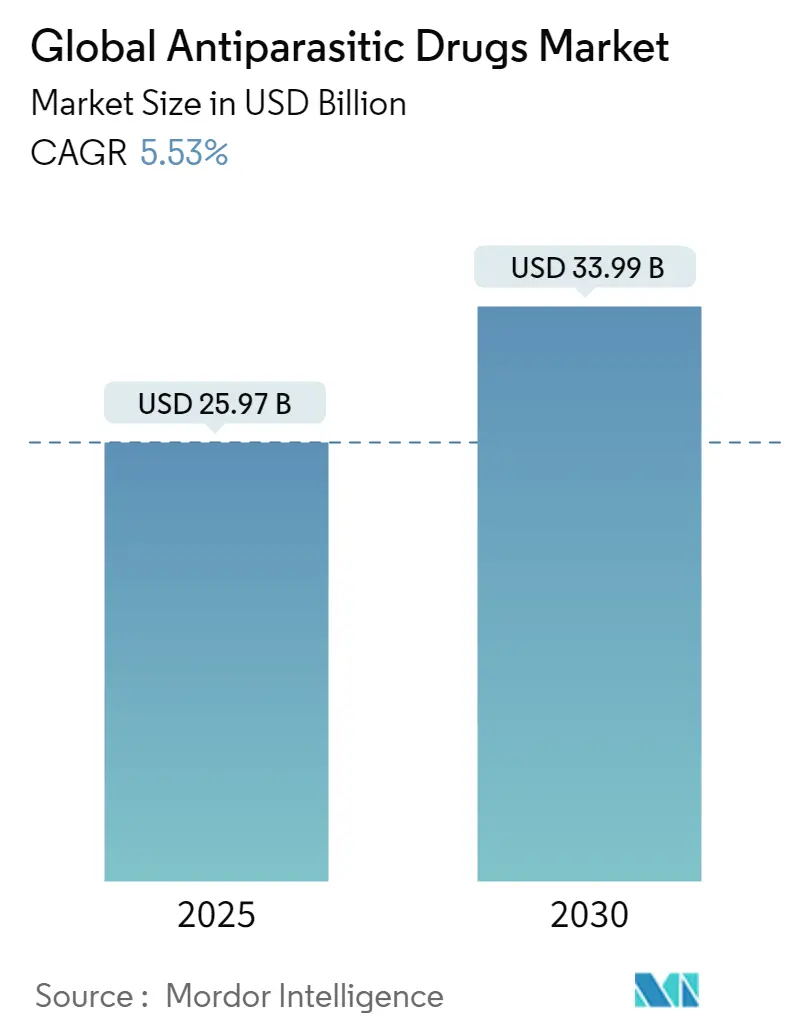
Global Antiparasitic Drugs Market Analysis by Mordor Intelligence
The antiparasitic drugs market size is currently valued at USD 25.97 billion in 2025 and is set to reach USD 33.99 billion by 2030, advancing at a 5.53% CAGR between 2025-2030. Growth is supported by wider mass-drug-administration (MDA) coverage, climate-driven expansion of vector habitats and an uptick in government-funded treatment programs. Heightened research spending on novel anthelmintic classes and rapid commercialization of long-acting macrocyclic lactones are opening new revenue streams even as escalating helminth resistance tempers overall momentum. Market leaders continue to consolidate pipeline assets, while emerging biotech firms focus on niche, unmet-need indications—all within a regulatory backdrop that is tightening eco-toxicology standards and pressuring active-ingredient supply chains.
Key Report Takeaways
- By drug type, anthelmintics led with 54.67% of the antiparasitic drugs market size in 2024, whereas antiprotozoals are forecast to post the segment-high 6.62% CAGR through 2030.
- By route of administration, injectable formulations accounted for 42.89% of the antiparasitic drugs market size in 2024; topical & implants are projected to expand at a 6.95% CAGR to 2030.
- By distribution channel, hospital pharmacies commanded 60.78% of the antiparasitic drugs market in 2024, while online pharmacies record the fastest growth at 7.12% CAGR from 2025-2030.
- By end-user, hospitals led with 46.83% of the antiparasitic drugs market share in 2024, whereas home-care settings are forecast to post the segment-high 7.23% CAGR through 2030.
- By geography, North America dominated with a 40.02% share of the antiparasitic drugs market in 2024; Asia Pacific is set to deliver the highest regional CAGR of 6.55% over the forecast period.
Global Antiparasitic Drugs Market Trends and Insights
Drivers Impact Analysis
| Driver | (~) % Impact on CAGR Forecast | Geographic Relevance | Impact Timeline |
|---|---|---|---|
| Expansion of Mass Drug-Administration (MDA) Campaigns | +1.8% | Global, with concentration in Sub-Saharan Africa, South Asia, Latin America | Medium term (2-4 years) |
| Climate-Driven Spread of Vector-Borne Parasitic Diseases | +1.2% | Global, with significant impact in tropical and subtropical regions | Long term (≥ 4 years) |
| Accelerating R&D Funding for Novel Anthelmintic Classes | +0.9% | North America, Europe, emerging biotech hubs in Asia Pacific | Medium term (2-4 years) |
| Rising International Travel & Migration Boosting Imported Parasitic Cases | +0.8% | Global, with concentration in developed regions receiving immigrants and travelers | Medium term (2-4 years) |
| Commercialization of Long-Acting Human Macrocyclic Lactones | +0.7% | Global, with early adoption in North America and Europe | Short term (≤ 2 years) |
| Government-Mandated Leishmaniasis Treatment Programs | +0.5% | Middle East & Africa, South America, South Asia | Medium term (2-4 years) |
| Source: Mordor Intelligence | |||
Expansion of mass drug-administration (MDA) campaigns
Worldwide MDA initiatives now reach more than 860 million people annually, with triple-drug regimens achieving 74% coverage—well above the 65% WHO benchmark. Scale-up in India alone covers 17.5 crore residents across 111 districts[1]Press Information Bureau, “National MDA Campaign for Lymphatic Filariasis Elimination,” pib.gov.in, amplifying volume demand for anthelmintics. Community-directed delivery models are improving adherence in remote areas, translating into reliable, repeat-cycle procurement for manufacturers. Early adoption of triple-drug strategies in developing nations delivered superior efficacy, encouraging additional donor funding and accelerating elimination targets.
Climate-driven spread of vector-borne parasitic diseases
Rising temperatures are extending mosquito and tick ranges, making malaria, babesiosis and Lyme disease more common in regions that once saw negligible incidence. Vector-borne illnesses now constitute over 17% of global infectious disease cases and claim 700,000 lives each year, boosting both prophylactic and therapeutic consumption[2]World Health Organization, “Vector-Borne Diseases,” who.int. Pharmaceutical pipelines increasingly emphasize broad-spectrum agents and combination therapies suitable for populations lacking prior immunity.
Accelerating R&D funding for novel anthelmintic classes
Investment momentum is evident in the discovery of species-selective complex I inhibitors[3]Giulia Del Borrello, “Identification of a Family of Species-Selective Complex I Inhibitors as Potential Anthelmintics Targeting Soil-Transmitted Helminths,” Nature Communications, nature.com that target helminth-exclusive metabolic pathways. Monoclonal antibodies aimed at the P29 protein in alveolar echinococcosis have also shown in-vivo potency without hepatic or renal toxicity. Next-generation screening platforms and computational chemistry are shortening lead-optimization cycles, broadening candidate pools beyond traditional benzimidazoles.
Commercialization of long-acting human macrocyclic lactones
Moxidectin’s 20-35-day half-life underpins six-month dosing schedules, improving compliance and limiting resistance pressure. Ghana’s 2025 community rollout distributed 250,000 doses[4]Medicines Development for Global Health, “Ghana Rolls Out Moxidectin,” ghicfunds.org, marking the first field deployment of a long-acting macrocyclic lactone. WHO’s proposal to add moxidectin to the Essential Medicines list is poised to standardize procurement, lower program costs and expedite elimination of river blindness.
Restraints Impact Analysis
| Restraints | (~) % Impact on CAGR Forecast | Geographic Relevance | Impact Timeline |
|---|---|---|---|
| Escalating Helminth Drug Resistance | -1.2% | Global, with highest impact in Sub-Saharan Africa and South Asia | Long term (≥ 4 years) |
| Integrated Vector Management Dampening Prophylactic Volumes | -0.7% | Global, with concentration in tropical and subtropical regions | Medium term (2-4 years) |
| Eco-Toxicology Scrutiny Slowing Isoxazoline Approvals | -0.5% | North America, Europe | Short term (≤ 2 years) |
| API Supply Disruptions in Benzimidazole Manufacturing Hubs | -0.4% | Global, with manufacturing concentration in Asia | Short term (≤ 2 years) |
| Source: Mordor Intelligence | |||
Escalating helminth drug resistance
Resistance-conferring β-tubulin mutations—F167Y, Q134H, E198K/V and F200Y/L—are now widespread in regions with frequent MDA cycles. Albendazole efficacy against Trichuris trichiura has dropped to 38.6%, forcing higher doses and costlier combination regimens. Limited arrival of new mechanisms of action jeopardizes the WHO roadmap for neglected-disease elimination.
Integrated vector management dampening prophylactic volumes
Deployment of environmental and biological controls is lowering malaria incidence without proportional rises in antimalarial use. As public-health agencies prioritize integrated strategies, pharmaceutical firms shift focus toward therapeutic indications and multi-action combinations that complement rather than compete with vector-control tools.
Segment Analysis
By Drug Type: Anthelmintics Anchor the Market Amid Resistance Pressures
Anthelmintics secured a 54.67% slice of antiparasitic drugs market share in 2024, reflecting the scale of helminthiasis worldwide. Benzimidazoles dominate sub-segment sales, though mounting resistance is sparking interest in macrocyclic lactones and enzymatic-pathway inhibitors. The antiparasitic drugs market size for macrocyclic lactones has grown on the back of moxidectin’s long-acting profile, while imidazothiazoles hold a niche role in combination regimens. Antiprotozoals, forecast to expand at 6.62% CAGR, are benefiting from novel delivery platforms and repurposed oncology compounds that target protozoal metabolism. Artemisinin-based combinations remain the cornerstone of malaria therapy, yet pipeline candidates aimed at resistant Plasmodium strains promise to diversify this revenue stream. Cutting-edge biologics for leishmaniasis and trypanosomiasis further reinforce the segment’s fast-growth status. Cross-resistance among parasite classes is also steering R&D toward multi-mechanism molecules to safeguard long-term efficacy.
Second-generation benzimidazole nano-formulations now exhibit improved solubility and bioavailability, extending product life cycles without altering active moieties. Macrocyclic lactone R&D is concentrating on polymer-based implants capable of releasing drug loads over several months—an approach expected to elevate adherence in endemic regions with limited healthcare access. Meanwhile, targeted screening platforms are leveraging AI to identify new chemotypes that bypass existing resistance pathways, adding depth to a historically narrow pipeline.
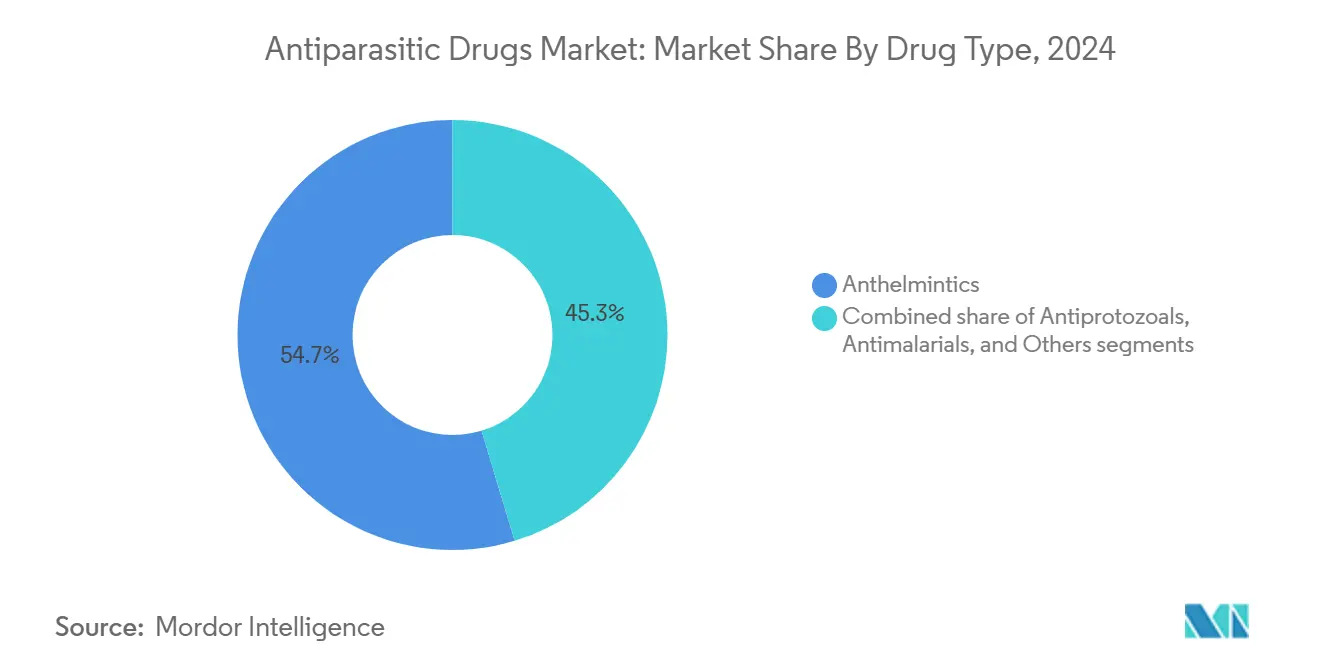
Note: Segment shares of all individual segments available upon report purchase
By Route of Administration: Injectable Dominance Faces Novel Delivery Competition
Injectables commanded 42.89% of the antiparasitic drugs market in 2024, driven by their utility in acute, hospital-managed infections. Intravenous artesunate remains the only severe-malaria option in the United States, validating the hospital-centric distribution model. Long-acting depot formulations of moxidectin are set to reinforce injectable relevance by ensuring plasma levels for six months with a single dose. Oral products, while convenient, are grappling with absorption challenges; nano-emulsion strategies now aim to boost bioavailability for highly lipophilic molecules like ivermectin. The antiparasitic drugs market size for topical & implants is forecast to expand fastest at 6.95% CAGR, propelled by sustained-release skin patches and subdermal devices that simplify dosing schedules and heighten compliance.
Transdermal microneedle arrays are under study as an alternative to conventional syringes, potentially democratizing access in low-resource settings. Polymeric implants embedding slow-release moxidectin have cleared early safety studies, suggesting that implantable systems could transition from veterinary to human use within the decade. Innovations in oral solid dispersions are likewise prolonging market life for legacy compounds, highlighting formulation science as a competitive lever.
By Distribution Channel: Hospital Pharmacies Retain Primacy as E-Commerce Accelerates
Hospital pharmacies represented 60.78% of the antiparasitic drugs market size in 2024. Stewardship toolkits such as the United Kingdom’s “Start Smart Then Focus” framework are refining inpatient prescribing, curbing misuse and, by extension, resistance. Online pharmacies, forecast to post a 7.12% CAGR, ride the telehealth wave, expanding reach to consumers previously constrained by geography. Regulatory moves by the U.S. DEA now permit telemedicine prescribing without in-person visits, unlocking new patient pools. Retail chains respond by augmenting consultation services and inventory management to stave off share erosion.
E-commerce giants are integrating authentication seals and AI-driven counterfeit detection, addressing quality concerns that have historically slowed digital uptake. Hospital outlets, meanwhile, capitalize on complexity: injectable macrocyclic lactones and amphotericin B derivatives still demand professional oversight, sustaining their channel dominance despite digital competition.
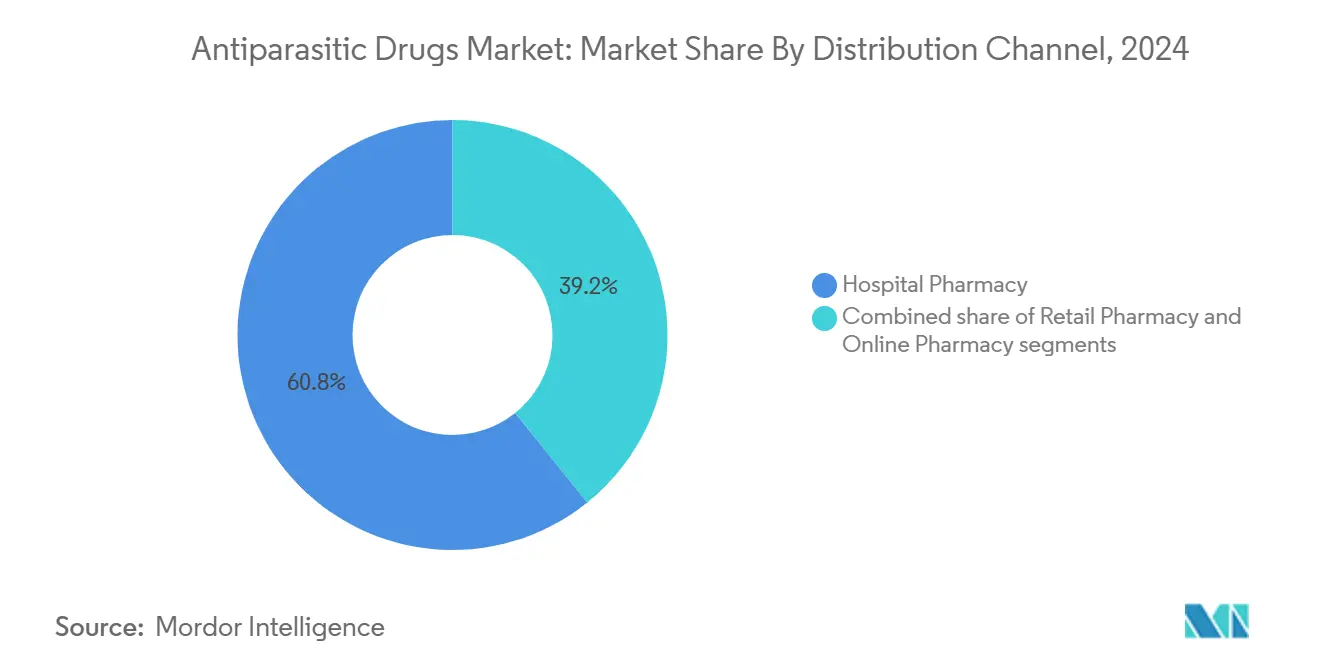
Note: Segment shares of all individual segments available upon report purchase
By End-User: Hospitals at the Core, Home-Care on the Rise
Hospitals remain the largest segment, with 40.02% market share in 2024, owing to the diagnostic and monitoring demands of severe malaria, visceral leishmaniasis and neurocysticercosis. WHO stewardship guidelines are incorporated into clinical protocols to optimize therapeutic windows and limit emergent resistance. Clinics provide frontline access, particularly in rural tropics, and increasingly leverage teleconsultation to link patients with urban specialists. Home-care settings is anticipated to exhibit the most rapid expansion, at 7.23% CAGR from 2025-2030, as user-friendly oral and topical preparations reduce the need for inpatient stays. Patients receiving high-risk antiparasitics at home report manageable symptom loads when supported by visiting nurses, validating the shift toward decentralization.
Geography Analysis
North America held 40.02% of antiparasitic drugs market share in 2024, propelled by robust R&D ecosystems, stringent quality controls and early adoption of next-generation agents. Commercial uptake skews toward premium formulations, mitigating lower volume demand. FDA guidance on off-label ivermectin communications underscores the nuanced regulatory climate. The region’s forecast CAGR of 4.48% reflects a mature yet innovation-driven environment, with new combination therapies aimed at resistance hot-spots.
Asia Pacific, expanding at 6.55% CAGR, combines high disease prevalence with widening healthcare coverage. India’s national lymphatic-filariasis campaign exemplifies public-sector purchasing heft, while China’s manufacturing base reshapes global supply chains for active ingredients. Japan’s research heritage continues to influence macrocyclic lactone innovations. Financial and geographic barriers—documented in Bihar’s visceral-leishmaniasis patient study—signal opportunities for low-cost, long-acting products.
Europe enjoys strong stewardship frameworks and eco-toxicology oversight, translating into cautious yet steady 4.12% CAGR growth. Regulatory emphasis on environmental sustainability is prompting companies to adopt greener chemistries early in development. The Middle East & Africa region gains momentum through mass-drug-administration success stories such as Zimbabwe’s 73% coverage campaign against lymphatic filariasis, while South America leverages PAHO’s Strategic Fund to stabilize procurement and entry pricing. These regions offer volume-driven growth potential despite funding constraints.
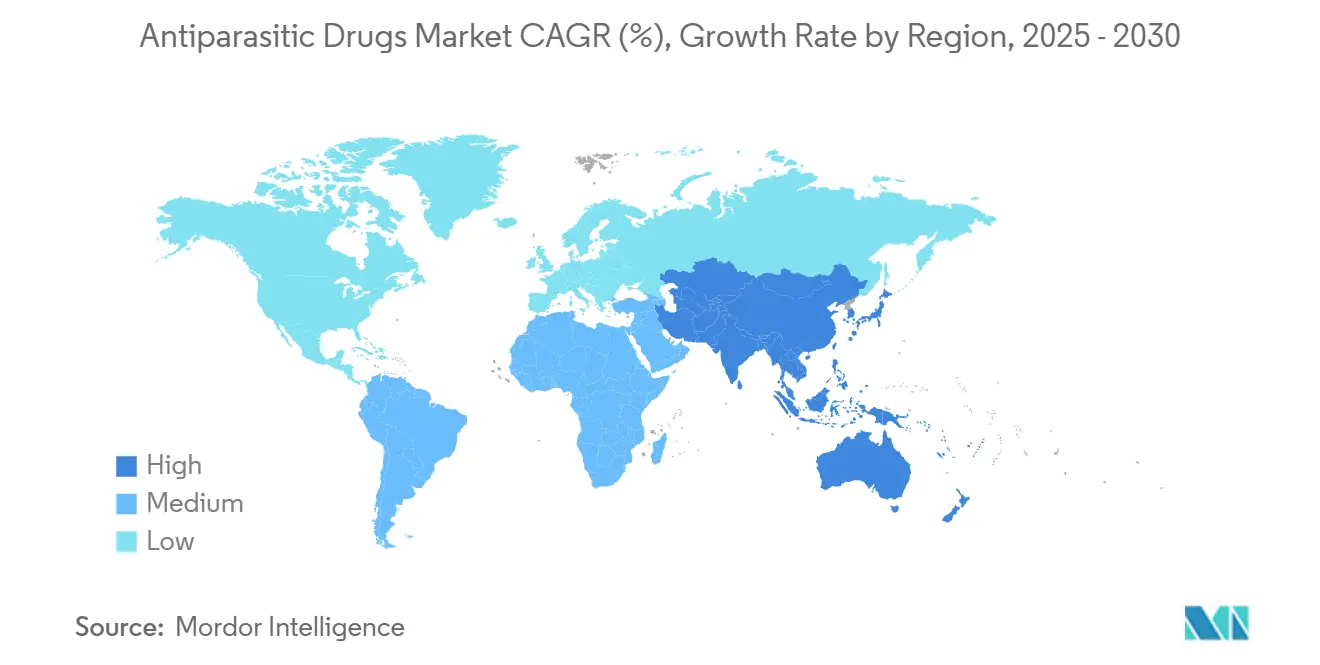
Competitive Landscape
Industry structure is moderately consolidated. GSK, Novartis and Pfizer deploy extensive R&D budgets and global distribution to defend leading positions, often through incremental reformulations that lengthen product life cycles. M&A activity increasingly targets biotech ventures with niche parasitology pipelines, accelerating access to novel mechanisms such as species-selective complex I inhibitors.
Generic manufacturers and regional producers intensify price competition in high-burden markets, pushing multinationals to differentiate via long-acting injectables and combination packs. Patents describing polymeric moxidectin implants exemplify competitive bets on adherence-focused innovation.
Digital health integration is emerging as a non-price differentiator. Telemonitoring apps linked to dosing reminders improve real-world adherence, offering manufacturers actionable pharmacovigilance data. Supply-chain resilience is now a board-level priority, with firms investing in dual-sourced APIs to mitigate regional disruptions.
Global Antiparasitic Drugs Industry Leaders
-
Bayer AG
-
GSK plc
-
Merck & Co., Inc.
-
Novartis AG
-
Pfizer Inc.
- *Disclaimer: Major Players sorted in no particular order
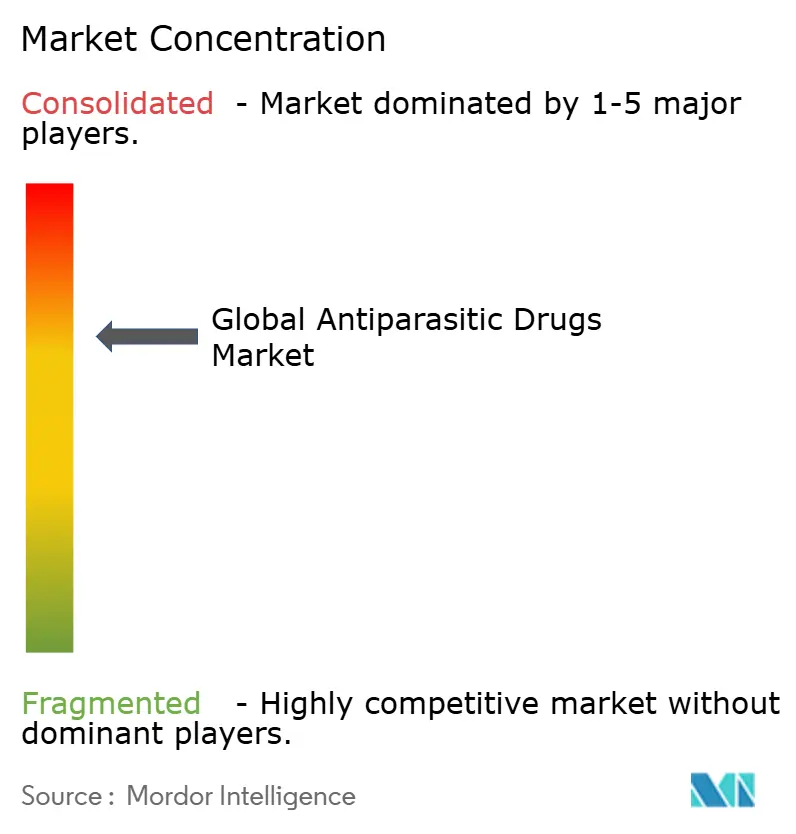


Recent Industry Developments
- April 2025: Appili Therapeutics gained FDA alignment on NDA requirements for ATI-1801, a topical paromomycin therapy for cutaneous leishmaniasis, positioning for submission later in 2025.
- February 2025: DNDi issued a regional elimination framework for visceral leishmaniasis in Eastern Africa, spotlighting integrated vector management and early diagnosis.
- January 2025: Ghana commenced community-wide moxidectin MDA for river blindness, distributing 250,000 six-monthly doses following 2024 FDA approval.
- July 2024: PAHO activated QuantMET within its Strategic Fund to optimize leishmaniasis medicine supply planning in endemic Latin American countries.
Research Methodology Framework and Report Scope
Market Definitions and Key Coverage
Our study defines the global antiparasitic drugs market as all human-use pharmaceutical preparations formulated to treat or prevent protozoan, helminthic, or ectoparasitic infections, regardless of route of administration or distribution channel.
Scope exclusion: Veterinary formulations and active pharmaceutical ingredient (API) trading are kept outside the numbers.
Segmentation Overview
- By Drug Type
- Anthelmintics
- Benzimidazoles
- Macrocyclic Lactones
- Imidazothiazoles
- Other Anthelmintics
- Antiprotozoals
- Antimalarials
- ACTs
- Nitroimidazoles
- Other Antimalarials
- Others
- Anthelmintics
- By Route of Administration
- Oral
- Injectable
- Topical & Implants
- By Distribution Channel
- Hospital Pharmacy
- Retail Pharmacy
- Online Pharmacy
- By End-User
- Hospitals
- Clinics
- Home-Care Settings
- By Geography (Value)
- North America
- United States
- Canada
- Mexico
- Europe
- Germany
- United Kingdom
- France
- Italy
- Spain
- Rest of Europe
- Asia-Pacific
- China
- India
- Japan
- Australia
- South Korea
- Rest of Asia-Pacific
- Middle East & Africa
- GCC
- South Africa
- Rest of Middle East & Africa
- South America
- Brazil
- Argentina
- Rest of South America
- North America
Detailed Research Methodology and Data Validation
Primary Research
Mordor analysts interviewed infectious-disease clinicians, formulary managers, and procurement heads across North America, Europe, Asia-Pacific, and Africa. Calls and short surveys clarified real-world treatment cycles, patient compliance, typical ASP discounts, and stock-out frequency, helping us close gaps left by uneven public reporting.
Desk Research
We began with structured searches across open datasets such as WHO's Global Health Observatory, the World Bank's disease burden tables, United Nations COMTRADE shipment codes, and regional regulators' Orange Books. Trade association dashboards, for example, the Infectious Diseases Society of America and Africa CDC, offered prevalence and treatment-rate clues. Company 10-Ks, investor decks, and patent families were scraped through D&B Hoovers and Questel to benchmark revenue splits and pipeline strength. National hospital procurement data and peer-reviewed journals supplied dosage mix and average selling price (ASP) ranges. This list is illustrative; many additional public records underpinned the desk effort.
Market-Sizing & Forecasting
A top-down model starts with notified production plus net import values, reconstructing the global demand pool after wastage adjustments and therapy adherence factors. We then corroborate totals through selective bottom-up roll-ups of sampled manufacturer sales and channel checks. Key variables fed into the model include malaria incidence, soil-transmitted helminth prevalence, treatment coverage ratios, median course pricing, and generic penetration trajectories. Forecasts use multivariate regression anchored on population at risk, GDP-linked spending elasticity, pipeline launch probability, and documented resistance trends; scenario analysis tests upside and downside swings.
Data Validation & Update Cycle
Outputs pass a two-analyst variance check, followed by senior review against independent health-spend series. We refresh the model every twelve months, with interim revisions triggered by approvals, major tender wins, or guideline changes, ensuring clients get the latest read.
Why Mordor's Antiparasitic Drugs Market Baseline is dependable
Published estimates often diverge because firms pick different inclusion criteria, price points, and refresh cadences. We explain below how those choices shift the headline number.
Key gap drivers include exclusion of hospital mark-ups, use of sell-in versus sell-out values, currency-conversion timing, and whether pipeline launches are front-loaded into the base year. By selecting notified production, adjusting to ex-manufacturer ASPs, and updating annually, Mordor reduces noise and offers a balanced midpoint.
Benchmark comparison
| Market Size | Anonymized source | Primary gap driver |
|---|---|---|
| USD 25.97 B (2025) | Mordor Intelligence | - |
| USD 19.44 B (2024) | Global Consultancy A | Omits retail mark-up and uses 2020 exchange rates |
| USD 17.9 B (2023) | Trade Journal B | Counts only prescription sales and excludes emerging markets |
In sum, the disciplined scope selection, dual-track modeling, and frequent refresh adopted by Mordor Intelligence give decision-makers a transparent, repeatable baseline they can trust when sizing opportunities or benchmarking performance.


Key Questions Answered in the Report
Which product category is witnessing the most innovation in the antiparasitic drugs market?
Macrocyclic lactones are receiving heightened R&D attention because their long-acting profiles improve patient adherence and can help delay resistance development.
How are digital channels reshaping access to antiparasitic medicines?
Online pharmacies and telemedicine platforms are streamlining prescription fulfillment, expanding reach to remote communities and challenging the dominance of traditional retail outlets.
What is the primary factor driving formulation advances in topical and implantable antiparasitics?
The need for sustained drug release that minimizes dosing frequency is motivating companies to invest in polymer-based implants and enhanced dermal delivery technologies.
Why are regulators placing greater scrutiny on isoxazoline approvals?
Rising eco-toxicology concerns about the impact of these compounds on non-target species have led agencies to demand deeper environmental-risk assessments before granting marketing authorization.
How is helminth drug resistance influencing corporate R&D priorities?
Documented resistance mutations in key parasites are pushing pharmaceutical firms toward combination therapies and entirely new mechanisms of action rather than incremental reformulations.
In what way are government-mandated treatment programs affecting market dynamics?
National initiatives for diseases like leishmaniasis are creating predictable, large-volume procurement cycles that lower commercial risk for manufacturers and encourage standardized treatment protocols.
Page last updated on:
